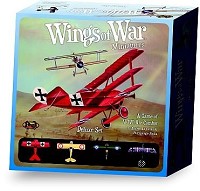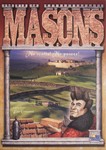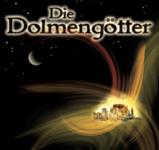July 2008 Archives

This time we had a slightly larger game of Wings of War: we had nine players and everybody wanted to play. Well, that's no problem at all, because we had a total of 11 planes available. I had the four from the Deluxe set, four planes from the second series of miniatures, an extra Fokker triplane and Petri had brought two planes as well.
So, we split 5-4 with Germans flying five planes in both games. To even out the game, the Allied forces had an extra plane they would use once the first player on their side was shot down. They didn't really need it - Entente ruled over Germany in both games.
The first game was pretty bad for me. Actually, it was horrible. In the first round, I fly close to enemies, get shot, explode on the first shot. Game over, now let's watch others fly for an hour... In the second game we didn't use explosions. It's probably a good idea when playing larger, longer games. In shorter games explosions are fine, especially if people play with multiple planes. That would be my preference, actually, since while the game works with nine, it's slightly confusing... Having, say, four players, with two planes each, would probably be a better experience.
But we had fun, and I think I'm doing a good job selling the game to other people... The extra miniatures were, also, a good thing to have.
Hannu dropped by to do some trading and he had a fifteen minutes to kill. I was out of Wings of War at that time, so we - of course - played cards. Le Truc, to be exact. It's a fun little game of trick-taking and bluffing. The game is played on a 32-card pack, with 7 and 8 high. Players get three cards and three tricks are played. No suits, high card wins and if the trick is tied, it's spoiled. The player who wins either two tricks or the first trick if one is spoiled, wins.
The winner gets one point (game is twelve points), except... either player can add to the value of the game. First increase doubles the value to two and from then on, each increase adds two points. It's also possible to add "my remainder" which means the amount of points you're missing from twelve. If the opponent refuses the increase, the doubler wins the hand.
It's a quick and brutal game. The hands often end before the first trick is finished: the elder hand drops down a card, says "two more?" for the double and the dealer surrenders. A killer 7-7-7 hand is actually pretty bad, because you can't really get your opponent to pay you points for it - poker players will know about this, how to milk your opponent most effectively.
Truc is a fun little game, and good fun for a short time: one game takes just 10-15 minutes so you either fill a small time period or play for best for three or five for a longer game.

My last game for the evening was Masons. It's a fun filler, pretty much, with all the die rolling. Our game took 40 minutes, which is perhaps 15 minutes too much for my enjoyment, but we had newbies in the game, so I suppose it's allright. At least we went under the suggested length of 45 minutes.
Next weekend we have Finncon, which is the biggest science fiction convention in Finland (and as far as I know, the biggest free con in whole Europe). I'm playing games there, of course... Finnish Board Game Society was at the previous Finncon organising some board game activity and that happens again this year. I'm running some train games: we're going to start with Steam over Holland, continue with West Riding and then with some shorter Winsome Games, depending on how much time we have left. Should be a pretty intensive experience!

Wings of War is one of those games I've wanted to try for a while now, with little success (and little effort, to be honest). Well, the arrival of the new Wings of War Miniatures Deluxe set helped to solve that little problem. Toni from Lautapelit.fi was kind enough to send me a copy (I did translate the game), and we were able to give it a go right away.
It's pretty cool. The mechanisms are clever, but what really makes it work is those miniatures. Funny enough, they actually make playing the game harder, but here looks go before usability: they're just so wicked cool. Everybody was instantly mesmerized by the small plastic planes. What a bunch of little boys we are, pretending to be grown men...
But the game is good. Each player commands a plane. The planes are moved by cards: each card has an arrow and you put one end in front of the plane and then move the plane where the arrow on the card is. The cards have all sorts of moves and maneuvres, depending on the plane. That's one neat thing: the planes are different. The triplane Fokker of the Red Baron fame is slower, but turns very tightly, while Albatross and SPAD are faster, but turn slower. Sopwith Camel turns faster to right than to left and so on.
It's all very clever. The moves are programmed three cards at the time and then executed simultaneously. This results in lots of confusion, of course, as the planes get the too close to each other. After each move, you can shoot, provided someone is in your firing range (and not too close).
It's not without problems. When the planes get close, the miniatures get pretty hard to handle with their bases and all. It's probably best to get rid of them for a while and stick to the cards, which overlap much better (the planes don't collide in this game, they can overlap - I suppose they just fly over and under each other). The bases are a bit slippery: we played on a wooden table and the handling of the planes wasn't that precise. When you can almost shoot someone, it's of course rather important to make sure you move exactly to where you should move... So it's better to play on a slightly sticky surface.
It's also a game of elimination. Our first game was fairly fast, but the second one took a while to finish and I had to wait quite a while after my early elimination (then again, it was my own fault - I had a brain fart and flew off the table).
In any case, it's great fun and the miniatures really make the game attractive. I definitely want to play this one more, and that doesn't seem to be a problem: everybody liked the game and wanted more...
After our two fights, we split our group. Me, Hannu and Riku played a game of Preference. This time we took a bit more than the five hands we played last week - a quick count from my notes suggests almost 20 hands. We didn't even finish: I had just six Pulya points when we quit. That's something the rules don't cover, but I sorted it out by converting my missing four Pulyas to 40 whist points, split equally between Riku and Hannu.
It was a very colourful session, with failed miséres from each player and lots of good hands. I was dealt bad cards all the time, of course, but I did win nonetheless, thanks to moderate amount of heap points and better whist play than Riku. I had a killer hand at one point, all diamonds except one, but Hannu bid misére without widow and I was such a coward I wouldn't bid nine diamonds (I probably could've, since widow had one ace, but then again...). Too bad, it was a very good hand.
But it was a fun game, that's for sure, and I really, really like Preference. It's exciting and fun, and I've learn to appreciate a good whist play (defending) more, since that was really the reason I won this time.
Another excellent game session this week! When I arrived, PitchCar sessions were over and people were choosing the next games. Hannu quickly got me and Gargoyle to join him in a game of Preference. Gargoyle was a newbie to this game, but he's no stranger to traditional card games so he learnt quickly.
It sure was an odd game. First of all, it lasted only five deals - minimum possible is three. Second, we saw two successful misére hands! Gargoyle played the first misére, filling his quota of ten points immediately. In the next hand, I got very good cards for misére and bid for it, but Hannu wouldn't accept that: he bid eight, I couldn't bid misére without the widow because I had an ace I had to dump, so he played the game successfully. It wasn't comfortable for him, but he did it.
In the next hand I bid misére again and played it, finishing the game: I had earlier played a seven, so I had four pulya points already, so the misére's ten filled my quota and the surplus was enough to fill Hannu's quota as well. I described four hands here: in the fifth one, Hannu failed a bid of six and took two heap points.
I won, because I had made 14 pulya points and thus got 40 whist points against Hannu, on top of the 16 I had before. Hannu had no whist points, while Gargoyle had some against me and some against Hannu. So, the final scores were 50 for me, 22 for Gargoyle and -72 for Hannu. These are very low scores: before, the spread has been something like 200 to -150. The lack of heap points caused the low scores, and since we had two miséres, there weren't lots of whist points.
It was an interesting, colourful game. Let's just say Hannu doesn't probably love the misére bid, not right now at least...

After Preference, we got a fourth player and Hannu went for his brand new Metropolys. It's a bidding-building game from Ystari that has garnered some reputation for an ugly board. I don't know - I've seen worse, and the pieces for players are pretty cool.
Each round players bid for building rights. Bidding is done with the pieces: everybody has a set of 13 buildings numbered 1-13. Someone starts by dunking a building on the board in one of the districts. Next player either passes or places a higher-numbered building in an adjacent district. This continues until everybody passes, somebody bids 13 or there's no room to place another building (the map has some borders, and you can't bid on an area where there is a building or a bid). Once the bidding is complete, the winning bid is turned upside down so the number doesn't show and all buildings used for bidding are returned to their owners.
That's it, pretty much. To give the game some structure, each player has two secret goals. One is based on the colour of the districts and other gives some special setting (districts connected with a bridge, districts around a statue, three-district chains and so on). Fulfill these and you score points. The districts also have chits that give bonus points or penalties. The game continues until somebody runs out of buildings.
It's pretty clever, really. Perhaps slightly too clever, too, as too much analysis might bog down the game. Secret objectives help there. Anyway, I found the game rather intriguing and charming - I kind of got the feeling I might want to buy the game, and that's fairly rare. Fortunately Hannu has a copy, I'll be able to play the game few more times to see how my feelings evolve. Right now I would buy a cheap copy right away.
In our game I was perhaps too hasty with my high-numbered buildings. I got stuck with all my low buildings, so I was pretty much out of the game for a long time in the end. A newbie mistake: when bidding, it's important to also think about future bidding power. Next time I'll know better. In any case, kudos to Sébastien Pauchon, designing both Metropolys and Yspahan is something worth being proud of.
Next up was a round of Slovenian Tarok, where I continued my good showing by playing a successful misére in the first deal. It's pretty hard one in Tarok, with the trumps and all, but then again, since everybody is forced to beat the cards played, some high cards are not a problem. Here I played the 21 in the first trick, hoping that the Skis wouldn't be in the widow. It wasn't, and my game went well.
Add to that two successful hands played with Olli and I was a glorious winner. Hannu got one good hand, but suffered from bad cards. Fortunately he and I got a free pass when Olli had made a mistake - we would've lost the hand, but since Olli didn't play trumps when he should've, he had to pay a penalty. He was second anyway, so it didn't hurt him too bad...
Pretty fun game, except for Hannu, I suppose. The cards didn't treat him well this time.

Last game of the evening was a three-player game of Die Dolmengötter. It's pretty good with three, too - not quite as much action as in the four-player game, but if the players don't actively avoid each other, it works. In our game I made a terrible blunder, playing my 4-point dolmen in the wrong place. To make it worse, I lost to Hannu by only two points: had I placed my dolmens the other way around, I would've scored four more points and won the game. Live and learn. Dolmengötter is definitely making its way to my all-time favourite game list.
